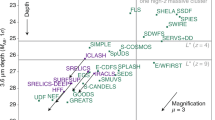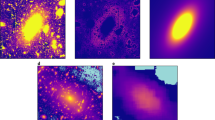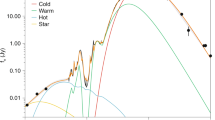Abstract
IT is well known that our counts of galaxies could be seriously biased by selection effects, largely determined by the brightness of the night sky. To illustrate this, suppose the Earth were situated near the centre of a giant elliptical galaxy, then the mean surface brightness of the sky would appear some 8–9 mag brighter than is observed from our position in the Galaxy (∼ 23 V mag (arc s)−2 looking toward the galactic pole, discounting atmospheric and zodiacal contributions1,2). Optical astronomers would then find extragalactic space an empty void; spiral and irregular galaxies would be quite invisible and all they would easily detect of galaxies would be the core regions of ellipticals very similar to their own. They would be blinded to much of the Universe by the surface brightness of their parent galaxy. But this blinding is clearly a relative matter and we should ask to what extent we are blinded by the spiral galaxy in which we exist, faint as it may appear by comparison. I will argue that strong indirect evidence already exists that our knowledge of galaxies is heavily biased by the sky background, and that the true population of extra-galactic space may be very different from the one we can see.
This is a preview of subscription content, access via your institution
Access options
Subscribe to this journal
Receive 51 print issues and online access
$199.00 per year
only $3.90 per issue
Buy this article
- Purchase on Springer Link
- Instant access to full article PDF
Prices may be subject to local taxes which are calculated during checkout
Similar content being viewed by others
References
Sears, F. H., Astrophys. J., 52 162 (1920).
Freeman, K. C., Astrophys .J., 160, 811 (1970).
de Vaucouleurs, G., Handbuch der Physik, 53, 311 (1959).
Fish, R. A., Astrophys. J., 139, 284 (1964).
de Vaucouleurs, G., IAU Symp., 58, 1 (1974).
Miller, R. H., and Prendergast, K. H., Astrophys. J., 136, 713 (1962).
Heidmann, J., Heidmann, N., and de Vaucouleurs, G., Mem. R. astr. Soc., 75, 85 (1971).
Arp, H., Astrophys. J., 142, 402 (1965).
Fisher, J. R., and Tulley, R. B., Astr. Astrophys., 44, 151 (1975).
Sargent, W. L. W., Astrophys. J., 160, 405 (1970).
Author information
Authors and Affiliations
Rights and permissions
About this article
Cite this article
DISNEY, M. Visibility of galaxies. Nature 263, 573–575 (1976). https://doi.org/10.1038/263573a0
Received:
Accepted:
Issue Date:
DOI: https://doi.org/10.1038/263573a0
This article is cited by
-
Comments on a dwarf elliptical galaxy with warm interstellar medium
Astrophysics and Space Science (2014)
-
Giant Low Surface Brightness Galaxies: Evolution in Isolation
Journal of Astrophysics and Astronomy (2013)
-
A class of compact dwarf galaxies from disruptive processes in galaxy clusters
Nature (2003)
Comments
By submitting a comment you agree to abide by our Terms and Community Guidelines. If you find something abusive or that does not comply with our terms or guidelines please flag it as inappropriate.



